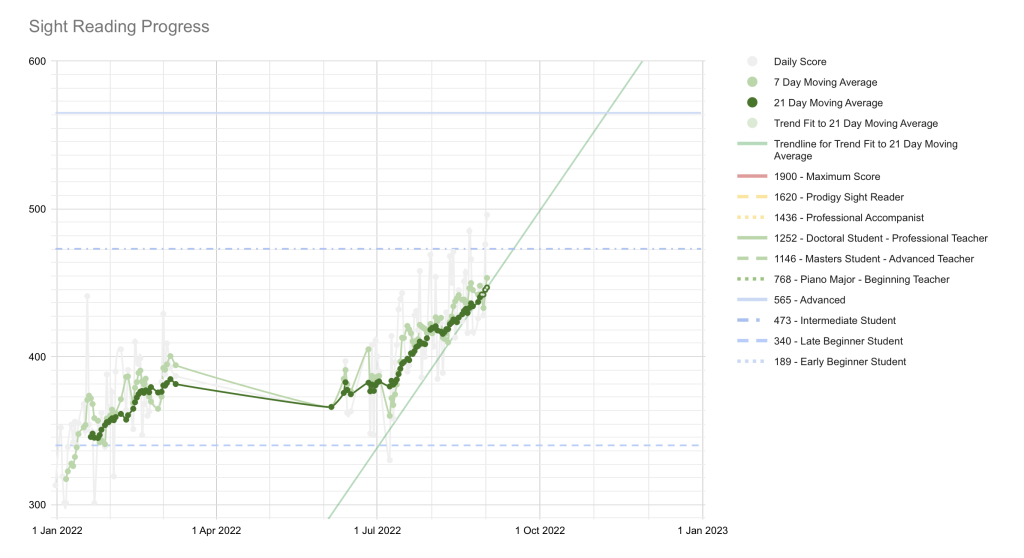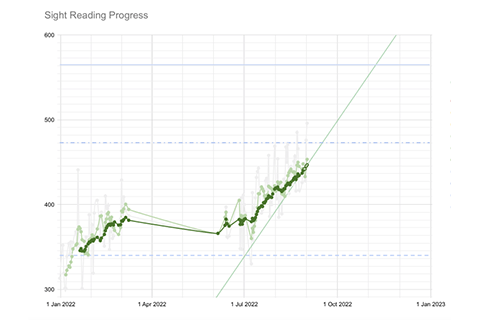Sight reading is the broccoli of music study. Everyone knows it is good for you. No one wants it.
My sight reading was (still is) lagging the rest of my musical development (except Aural – which is even worse) and I set about to fix that over the period of 6 months and I’m part way through that journey. My goal was to bring my sight reading up to the level I am studying at (Trinity grade 4) and, if I’m able, well past that.
I’ve had good results by pushing three separate areas of sight reading study and I wanted to jot down some pointers on these. Hopefully they’ll be helpful for you too.
I am a beginner at this so take my advice with a grain of salt, etc.
Why is sight reading important?
Check out this video:
Dr John Mortensen has a wonderful way of pointing out the obvious.
“If you’re studying music and music is your thing, it’s your language, why would you not want to be fluent in reading in your language? If you’re an English major and not very good at reading words, I would wonder about that. If you’re a Math major and you’re not very good at reading numbers … what’s going on? So, just as a matter of aptitude and competence and professionalism and just pride, you should want to be a great [sight] reader no matter what.”
Dr John Mortensen
The rest of the video is well worth a watch and he has a YouTube channel full of wisdom.
I think sight reading should be thought of as a forcing function for other areas of your musical studies that you might otherwise neglect. These are:
- Literacy and shape recognition. As you head towards intermediate level piano, you’re going to encounter chord patterns increasingly and pulling these apart note by note is not an option. Being able to directly map from chord shapes to motion is as foundational as being able to read basic single notes when you were starting out.
- Never stop. When we adults start the piano we cannot resist the desire to correct mistakes. Keeping the beat and ignoring mistakes and just pushing forward is without a doubt one of the hardest skills I have had to develop in my early piano studies.
- Proprioception. You’ll often be told not to look at your hands but not necessarily have why of this explained perhaps other than just that spatial awareness is important. I’ll write more on this later.
Materials / Apps
I’ve leaned heavily on Piano Marvel in my sight reading studies. The app is not without its problems in terms of being buggy and slow however it has been essential in:
- Forcing me to follow the beat. The app provides constant pressure to perform with correct rhythm and tempo in a way that you’re probably not disciplined enough to do so when left to your own devices.
- Providing me with a large library of arbitrary sheet music I otherwise would not play and this sheet music is ranked by difficulty so it is easy to find grade-appropriate things to play.
- Measuring progress with the standard assessment of sight reading (http://standardassessmentofsightreading.com/) feature. This has been essential in keeping me motivated.
At AUD$159.99 per year it is good value for what it does. I wish it was a more refined software product without the janky performance and bugs but it is the best of a bad bunch.
I’ve also used some specific exercises from my teacher as well.
What I achieved
I have had numerous stabs at being ’good’ at sight reading over the past two and a bit years. I was earnestly going to immerse myself in it at the start of 2022 however it quickly fell by the wayside as I focused on getting Trinity Grade 3 done and dusted.
As a part of my daily routine I do a SASR assessment. My scores swing wildly on a day to day basis and it is best not to focus on those. I’ve created a couple of averages to get the noise of out of the graph. Below you can see the raw data (faint grey), 7 day average (light green) and 21 day average (dark green). The 21 day average is the line I’m really trying to move as it is a good indication of my progress without dealing with the outliers of having a really bad or really good day.

So the progress is encouraging – I just need to stick at it.
My Daily Sight Reading Routine
My daily routine for sight reading has been around about half an hour per day with a bit more on the weekends. It covered each of these areas.
Literacy and shape recognition
The most common piece of sight reading advice you will receive is to read, and keep reading. Digest every piece of sheet music you can lay your hands on and just keep on chewing through it.
This is really good advice however as a beginner it is often difficult to understand whether a piece is at your level. Piano Marvel helps a lot with this as the pieces are all categorised and if you follow one of the courses (like Sight Reading Samurai or the Method or Technique sections) then you cannot progress until you get a score of at least 80% in any given piece.
This is a really good forcing function to work on technique where you are rusty. I am notorious for putting aside things that I don’t like because they’re too difficult however you cannot hide from the levelling system in Piano Marvel… you have to progress the piece if you want to move on.
As you progress through the levels, Piano Marvel will ensure that the difficulty is ratcheted up incrementally and you’re exposed to new concepts as you’re ready to digest them. I have found its way of incrementally adding in chord shapes very valuable and my level of comprehension of mapping chord shapes on a score to direct hand configurations and playing them to have increased very rapidly.
Never Stop
Learning to never stop and always follow the beat is a difficult skill to acquire. Again, using Piano Marvel here has been beneficial. Whether you’re trying to progress through one of its method sections or progress your SASR score, knowing you’re being graded by a computer keeps firm pressure on you to perform.
There is a pressure to continue to play that Piano Marvel exerts that is very hard to emulate when you’re by yourself. A teacher does a much better job of Piano Marvel but our time with our teachers is quite limited and Piano Marvel is a good surrogate.
Proprioception / Kinaesthesia
You are not reading sheet music if you’re looking at your hands.
We’re often told to not look down to develop better awareness of the keyboard geography but it is hard to adopt a difficult habit if no one explains why.
Proprioception (also known as kinaesthesia) is our body’s ability to know where our different bits and pieces are in space without necessarily seeing them. Close your eyes and try and touch your nose with your index finger or put your pinky in your ear and you’ll be able to do so easily. We take this for granted but it is quite remarkable if you stop and think about it.
Your body constantly sends information to the brain from your muscles, tendons, and joints and you brain uses this information to synthesise an idea of where your limbs and phalanges are.
If you want to manage complex fine motor movements while reading sheet music then dialing up your proprioception capabilities concurrently with your sight reading is essential. I used a few techniques for this:
- Piano Marvel (again). It forces you to never stop and that means you have to focus on the score and learn to make your hands follow.
- Don’t Look Down exercises. My teacher, Julia Kourtidis (http://www.jkmtuition.com/) has a series of exercises in increasing difficult that I use daily. The content of the exercises is not as important as the fact that you’re consciously making a decision to do a thing to move proprioception forward. It is an independent skill that you need to stay on top of.
How much time does this take?
In terms of time devoted to moving sight reading forward, I have spent on average:
- 10-15 minutes per day on reading new material in Piano Marvel.
- 10 minutes per day on Don’t Look Down exercises to dial up my proprioception.
- 10 minutes per day in doing a daily single run through the Standard Assessment of Sight Reading. SASR really counts as both new material and also Don’t Look Down style study.
Next Steps
As a control to the above, I have abandoned my daily routine described here in favour of just reading the sheet music other family members have left laying around.
I intend to do this for three weeks to see what that does to my SASR scores as a comparison to my three part routine of focusing. Early signs are not good – I’ll post an update when I’ve finished doing that experiment.
In the meantime, keep on reading and never stop!
